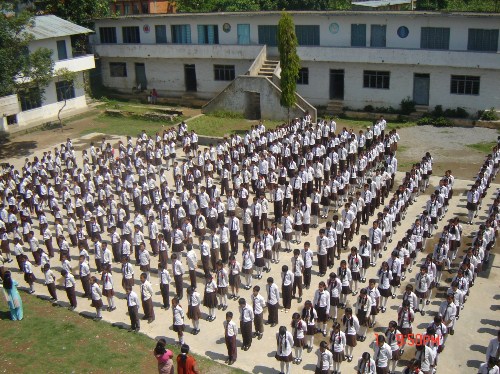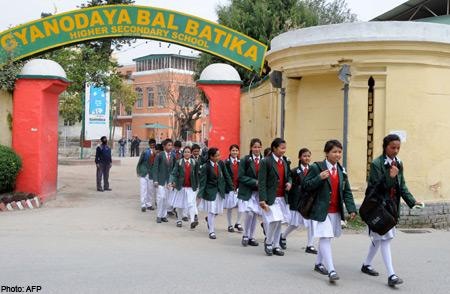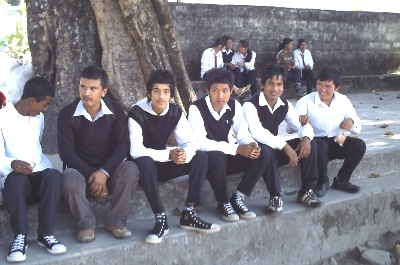
Education in Nepal
The Education System With particular reference to Pokhara.
General Nepal, the 12th poorest nation on earth, has a stable democratic Government and does its best to supply free education for all. It spends an estimated annual £56 on each child at school. This pays just for schooling, teachers’ wages, school buildings, but not for students’ travel, uniform, books or exam fees. The salary of a Government primary teacher is typically £700 a year. Head teachers might earn £850 a year. Children are enthusiastic about school. Many travellers will recall seeing lines of poor-looking children in uniform, hurrying to school. All wear some kind of uniform. Each school day begins with prayers.

The quality of education in Government schools is often not high and parents able to afford it seek private schooling if at all possible, sometimes at considerable personal cost. An effect of this is that Government schools lose the brightest and richest children, lowering the quality of those who remain.
Education levels:
Fishtail Students: Students start secondary school in Year Eight. The school year begins in July and ends in April/May. There is a small exam at the end of each school year shown as a percentage. At the end of Year Ten (aged around 16) they sit the exam in March and the results come out in June. The new 2017 name for this exam is the SEE (Secondary Education Exam). The marks range from 5 (top mark) to 1 (lowest mark). Clever students will score averages from 2.9 to 3.6.
Fishtail Plus Students: the school year starts in July and ends in April / May. They sit an intermediate exam at the end of the first year in May. At the end of the second year (aged around 18) they sit the SLC (School Leaving Certificate) in May/June, with results in June. The marks are shown as percentages.
College Students: the colleges start the year at different times, often September or April. Students have an intermediate exam at the end of each year (components can be retaken), with Finals at the end of the course.
- Primary school Ages 6-10: Grades 1 – 4 (89% of the children)
- Secondary school Ages 10-16: Grades 5-10 (44% of children begin secondary education. However many have drifted away by 16 particularly in poorer rural areas) Sometimes children stay down a year for social or educational reasons. At Grade 10 (typically age 16) pupils sit the all-important SLC or School Leaving Certificate, similar to our GCSE. SLC exams start in March, with results by June. The pass mark is 40% across all subjects. Only 19% of state school students achieve that pass, whereas 89% of private school students pass. Therefore, for our first 3 FF students to pass with grades of around 70% is a massive achievement.
- College or Sixth Form at same school Ages 16-17: (15%)
- University (1%)


Staying – on rates: most children start school but then many drift away. At this school visited by a Trustee, only four fourteen-year olds were still attending
In Government schools, the lessons are free. However students have to pay for travel (the schools may be further from home), uniform, stationery and textbooks. This is where the Fishtail Fund offers support.
The other category of schools are those run and partly or fully funded by private individuals, private organizations and religious groups. The ones that accept government funds are called ‘aided’ schools. The private ‘un-aided’ schools are fully funded by private groups.

In private schools standards (and fees) are high
The standard and the quality of education are quite high. Most of the middle class families send their children to such schools, which might be in their own city or far off, like boarding schools.
Even more affluent parents send their children to schools in India.
Thus social disadvantage is closely linked to educational disadvantage. For Fishtail Fund students, very clever but very poor, overcoming such obstacles is a major success.
Furthermore Government schools use the local language for their teaching, with English as a taught subject. Private schools, crucially, teach in English. This puts our Fishtail Fund students at a considerable disadvantage in opportunities in education.
College and Sixth Form

College students in Pokhara
Less than 20% of Government school pupils pass the SLC. Therefore to qualify for college is a major achievement for Fishtail students. Also the costs are higher: colleges may be further away meaning students being longer away from home and therefore able to help less at home or in the fields; textbook costs are higher.
There are Government-supported colleges where the teaching is free. However the quality of teaching is poor. Most education at this level is provided by the private sector.
University

Other topics
The call of cash
Many clever Nepali students are enticed abroad by the attraction of big bucks in Europe and America. We are aware that this might happen to our Fishtail youngsters. We hope to persuade them that the investment we have made in them is best repaid by them staying at home and helping to improve their own country.
